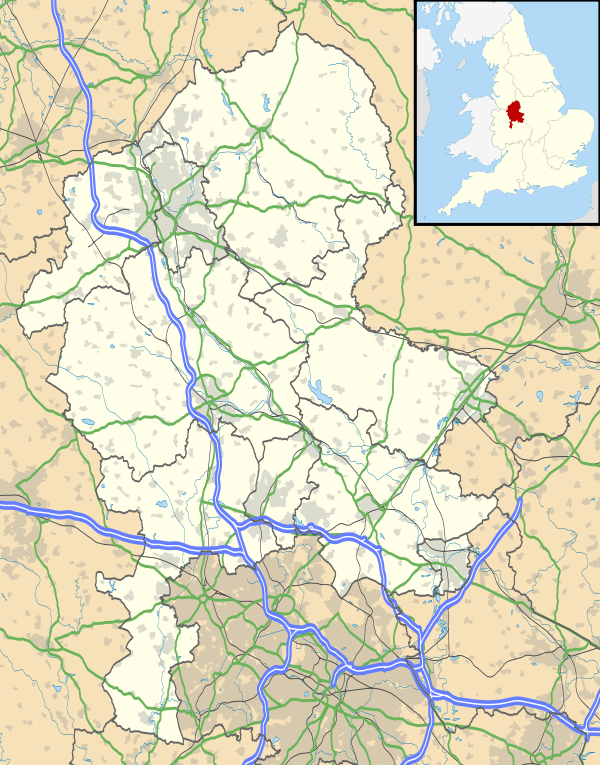Fenton, Staffordshire
| Fenton | |
| Christ Church, Fenton |
|
 Fenton |
|
| Population | 12,070 (2011.Wards)[1][2] |
|---|---|
| OS grid reference | SJ897446 |
| Unitary authority | Stoke-on-Trent |
| Ceremonial county | Staffordshire |
| Region | West Midlands |
| Country | England |
| Sovereign state | United Kingdom |
| Post town | STOKE-ON-TRENT |
| Postcode district | ST4 |
| Dialling code | 01782 |
| Police | Staffordshire |
| Fire | Staffordshire |
| Ambulance | West Midlands |
| EU Parliament | West Midlands |
| UK Parliament | Stoke-on-Trent South |
|
|
Coordinates: 52°59′52″N 2°09′28″W / 52.9977°N 2.1578°W
Fenton is one of the six towns in the city of Stoke-on-Trent which federated in 1910. In the south-east of the city, Fenton has been dubbed the town Arnold Bennett forgot as he called his fictionalised version of Stoke-on-Trent the Five Towns.
History
Etymology
The name Fenton means 'fen farm'.
Administration
Fenton started to become populated as a group of farms and private small-holdings were built there, alongside a lane running from the southern reaches of Hanley (by 1933 this lane was very busy and given the title of the A50).
Around the 1750s, the land was commonly known as Fenton Vivian. By the 1850s, the area around Duke Street and China Street had become populated during the rapid development of the Potteries.
Potters settled in Fenton in large houses alongside their pot-banks. Such houses include Great Fenton Hall, Fenton House (home of the Baker family), Heron Cottage and Grove House.
The two principal districts, Fenton Vivian and Fenton Culvert – each with their scattered communities, were brought together to make an urban district with its own board of guardians in 1894.
On 1 April 1910, the town was federated into the county borough of Stoke-on-Trent. By 1925 the area was granted city status.
Industry
Fenton has been the home of a number of potteries such as Coalport and Baker & Co, and its architectural heritage includes listed bottle ovens.[3]
WW I
During the First World War Fenton was bombed by Zeppelin 'L 21'.
Geography
It is within easy reach of the A500, A34 and the A50, a short distance away from Longton, Hanley and Newcastle.
Suburbs
Although Fenton has large industrial plants, particularly from the Potteries trade, it has always been considered more of a residential area.
Fenton includes Heron Cross, Mount Pleasant, Saxonfields, Pool Dole and Fenpark.
Places of interest

Fenton Manor has a swimming pool, gym and fitness centre, and a 1,300-seater arena. Fenton Park has football pitches, pavilions and playground. The town’s library on Baker Street, a Carnegie library, is now closed. Fenton also had a magistrates court, which served the city from within Fenton’s old town hall, built in 1888 by local pottery owner William Meath Baker at his own expense, to a design by Robert Scrivener. It closed in 2013.
Economy
Fenton differs from the other Potteries towns in that it doesn’t have a town centre. Instead, amenities and shops are spread over a sizeable area.
Notable people
Trivia
In the Jorge Luis Borges short story The Garden of Forking Paths, Dr. Yu Tsun goes to a suburb of Fenton to meet Stephen Albert.
References
- ↑ "Fenton East Ward, Stoke MBC population 2011". Retrieved 21 December 2015.
- ↑ "Fenton West and Mount Pleasant ward.Stoke MBC population 2011". Retrieved 21 December 2015.
- ↑ "Listed Buildings in Stoke-on-Trent". Thepotteries.org. Retrieved 2013-02-28.
External links
| Wikisource has the text of the 1911 Encyclopædia Britannica article Fenton. |
| Wikimedia Commons has media related to Fenton, Staffordshire. |
- Use interactive maps to find historic artefacts and photographs of old Fenton at exploringthepotteries.org.uk
- Town profile at The Sentinel (local newspaper)